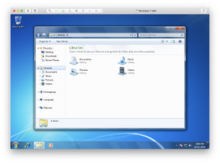VMware Fusion
 VMware Fusion running Windows 7 on macOS 10.14.6 Mojave | |
| Developer(s) | VMware |
|---|---|
| Initial release | August 6, 2007 |
| Stable release | 12.2.4[1]
/ July 21, 2022 |
| Written in | C, x86 Assembly, C++ (GUI)[citation needed] |
| Operating system | macOS |
| Platform | Apple–Intel architecture |
| Type | Hypervisor |
| License | Commercial proprietary software |
| Website | Official website |
VMware Fusion is a software hypervisor developed by VMware for Mac computers. VMware Fusion allows Intel-based Macs to run virtual machines with guest operating systems—such as Microsoft Windows, Linux, NetWare, Solaris, or macOS—within the host macOS operating system.
Overview
VMware Fusion, which uses a combination of paravirtualization and hardware virtualization made possible by the Mac transition to Intel processors in 2006, marked VMware's first entry into Macintosh-based x86 virtualization.[2] VMware Fusion uses Intel VT present in the Intel Core microarchitecture platform.[3] Much of the underlying technology in VMware Fusion is inherited from other VMware products, such as VMware Workstation, allowing VMware Fusion to offer features such as 64-bit and SMP support.[4]
VMware Fusion 1.0 was released on August 6, 2007, exactly one year after being announced.[5]
VMware Fusion can run any of hundreds of operating systems provided by the user,[6] including many older versions of macOS, which gives users a way to run older Mac application software that can no longer be run under the current version of macOS, such as 32-bit apps[7] and Rosetta (PowerPC) apps.[8]
System requirements
- Most Apple Macs launched in 2012 or later for VMware Fusion 12,[9][10] most Macs launched in 2011 or later for VMware Fusion 11,[11] any x86-64 capable Intel Mac for VMware Fusion 8[12]
- 4 GB of RAM (minimum)
- 750 MB free disk space
- 5 GB free disk space for each virtual machine (10 GB or more recommended)
- macOS Catalina or later for VMware Fusion 12,[9] Mac OS X 10.11 El Capitan or later for VMware Fusion 11,[11] Mac OS X 10.9 Mavericks or later for VMware Fusion 8[12]
- Operating system installation media for virtual machines
- Optional: nVidia GeForce 8600M, ATI Radeon HD 2600 or better graphics for Windows Aero support
See also
References
- ^ "VMware Fusion 12.2.4 Release Notes". docs.vmware.com. Retrieved 2022-08-26.
- ^ Griffiths, Rob (May 2007). "VMWare: New kid on the block". Macworld Australia (112): 36–37.
- ^ "Change the Preferred Virtualization Engine". pubs.vmware.com. Retrieved 2020-07-30.
- ^ "VMware Fusion Capabilities". pubs.vmware.com. Retrieved 2020-07-30.
- ^ Cohen, Peter (2006-08-06). "WWDC: VMware brings virtual machines to Mac OS X". PCWorld. Retrieved 2020-07-30.
- ^ "Fusion – Run Windows on Mac". www.vmware.com. Retrieved 2020-07-30.
- ^ Mendelson, Edward (2019-10-12). "How to Run 32-Bit Apps in macOS Catalina". PC Magazine. Retrieved 2020-07-30.
- ^ Snell, Jason (2011-11-18). "VMware Fusion update lets users virtualize Leopard, Snow Leopard". Macworld. Retrieved 2020-07-30.
- ^ a b "VMware Fusion 12 Release Notes". docs.vmware.com. Retrieved 2020-10-07.
- ^ "macOS Catalina is compatible with these computers". Apple Support. Retrieved 2020-10-07.
- ^ a b "VMware Official Web Site: System Requirements". VMware, Inc. Retrieved 2020-07-30.
- ^ a b "VMware Official Web Site: System Requirements". VMware, Inc. Archived from the original on 2016-03-04. Retrieved 2020-07-30.
Further reading
- Griffiths, Rob (June 2008). "Best of BOTH Worlds: OS X and Windows". Macworld. 25 (6): 66.
- Roy, Michael (2014). Instant Getting Started with VMware Fusion. Birmingham, UK: Packt Publishing. ISBN 9781782177883. OCLC 871189802.
- Silverman, Dwight (2008). "Using VMware Fusion". Running Windows on your Mac. Berkeley, Calif.: Peachpit Press. pp. 77–108. ISBN 9780321535061. OCLC 213384303.
- Taylor, Dave (May 2008). "Running Ubuntu as a Virtual OS in Mac OS X". Linux Journal (169): 80–83.
